How to Make a Cover Page: Illustrative Formatting Examples
Table of contents
- 1.1 MLA Style Cover Page
- 1.2 APA Style Cover Page Format
- 1.3 Chicago Style Cover Page Format
- 1.4 ASA Style Cover Page
- 1.5 Harvard Cover Page Format
- 1.6 Bottom line
A perfect cover page is an essential part of an essay’s presentation. It can make a great first impression on your instructor and set the tone for your essay. First, to write a cover page, understand your assignment’s formatting requirements. This includes the required format for the cover page, which may vary depending on your instructor’s or institution’s guide.
Once you have this information, you can create a title page that looks professional. It should include the title of your essay , your name, the course title, and other pertinent details. In this guide, we’ll walk you through how to make a cover page for an essay. This article will show the following:
- We’ll describe how a good cover page should look.
- In the article, we offer you examples of different formats of a cover page, including MLA, APA, and more.
- You’ll know the measurements you require to position some cover page aspects.

What Does a Paper Cover Page Look Like?
Creating a cover page for an essay in grade school was simple – add your name and date, and it’s done. However, structuring an essay and following grammar rules in university involves multiple steps that may be unfamiliar to you. But knowing how to format an essay can make the process easier. However, it can be overwhelming to determine the appropriate structure and ensure that your essay adheres to grammatical rules.
A well-designed cover page is crucial for an essay’s presentation; many students wonder how to make one. Therefore, we have compiled a guide on creating a title page for the most commonly used citation formats you may come across.
A cover page is a separate page at the beginning of your academic essay. It contains the title and author’s name and may also feature details like page number, course name, instructor name, and more. Remember that it’s essential to format your page consistently with the rest of your essay.
Use these tips when writing your cover page:
- Keep every margin at 1 inch;
- Select a font that’s easy to read. We’d recommend Times New Roman and Arial for this;
- Always keep the font size at 12;
- Use double-line spacing.
MLA Style Cover Page
The MLA cover page has a vague format for essay pages. Instead, formatting guidelines are based on your teacher’s preferences and standard MLA (Modern Language Association) text formatting. You can follow some best practices to create an MLA essay cover that looks professional. A typical sample MLA cover centers essay titles about one-third of the page’s length. You can also use italics or bold lettering to emphasize important words or phrases.
In our sample MLA format cover, including the necessary MLA heading in the top-left corner is crucial. Follow this guide for proper writing of the cover page template:
- Instructor’s name;
- Page number half an inch away from the top;
- Your name is an inch away from the top;
- The arrangement of the details is an inch away from the leftmost side of the sheet, while ensuring it’s double-spaced throughout;
- A half-inch indent in the first paragraph.
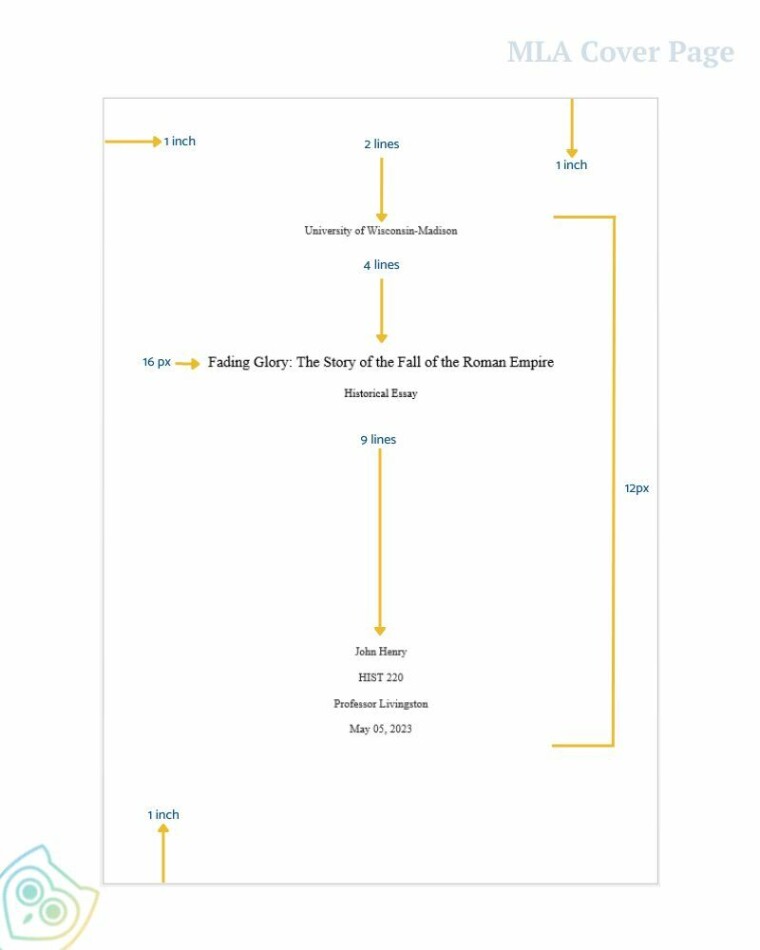
APA Style Cover Page Format
The APA citation format is widely used in the academic and business worlds but has some challenging aspects. For this reason, many busy students order cheap essays to avoid dealing with the nuances of APA essay cover. For your APA cover page, keep your essay’s title brief, under 12 words, and center it. Below the title, include your first, middle, initial, and last names without academic credentials like a PhD. On the following line, indicate your research location, usually your university. Below are the properties of the APA cover page format:
- The title of the paper, centered at the top of the page.
- Your name (student’s name), centered below the title.
- The institutional affiliation (college or university name), centered below your name.
- Course name and number.
- You professors’/instructor’s name.
- Optionally, you can include a running head aligned to the left margin (with the words “Running head:” followed by a shortened version of the title).
- Finally, include a page number in the top-right corner.
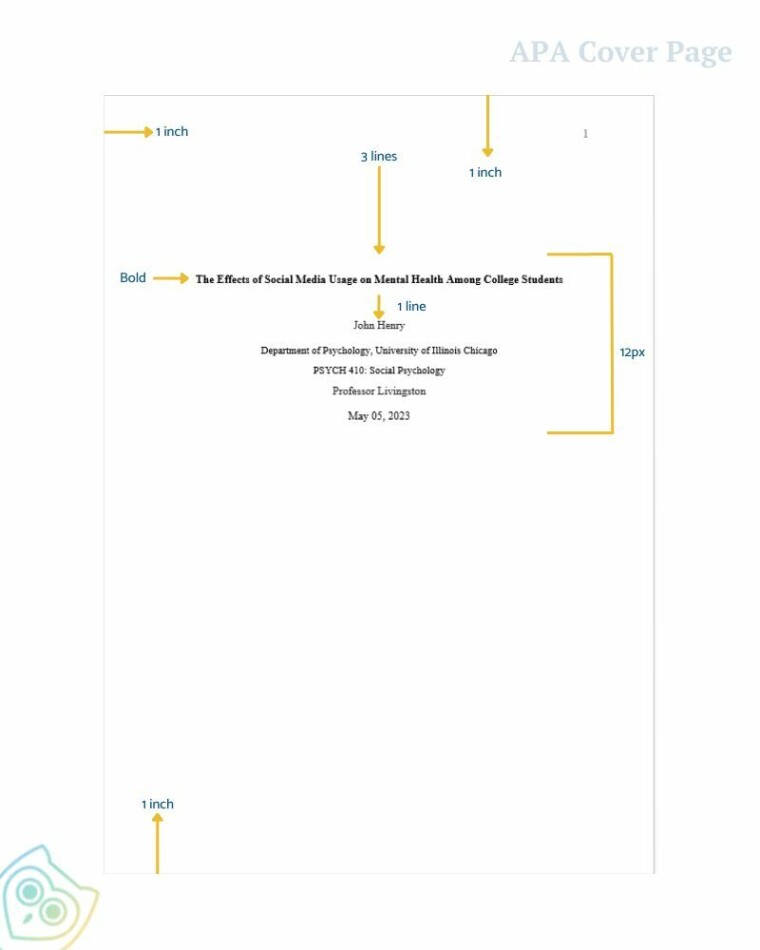
Chicago Style Cover Page Format
The Chicago page format, commonly called Chicago style paper, is a popular citation format used in the humanities department. The Chicago cover page format typically includes the following:
- The title of your essay centered on the page and in the title case (i.e., the first letter of each major word is capitalized);
- Your name is centered below the title;
- The course title is centered below your name;
- The instructor’s name is centered below the course title;
- The due date is centered below the instructor’s name.
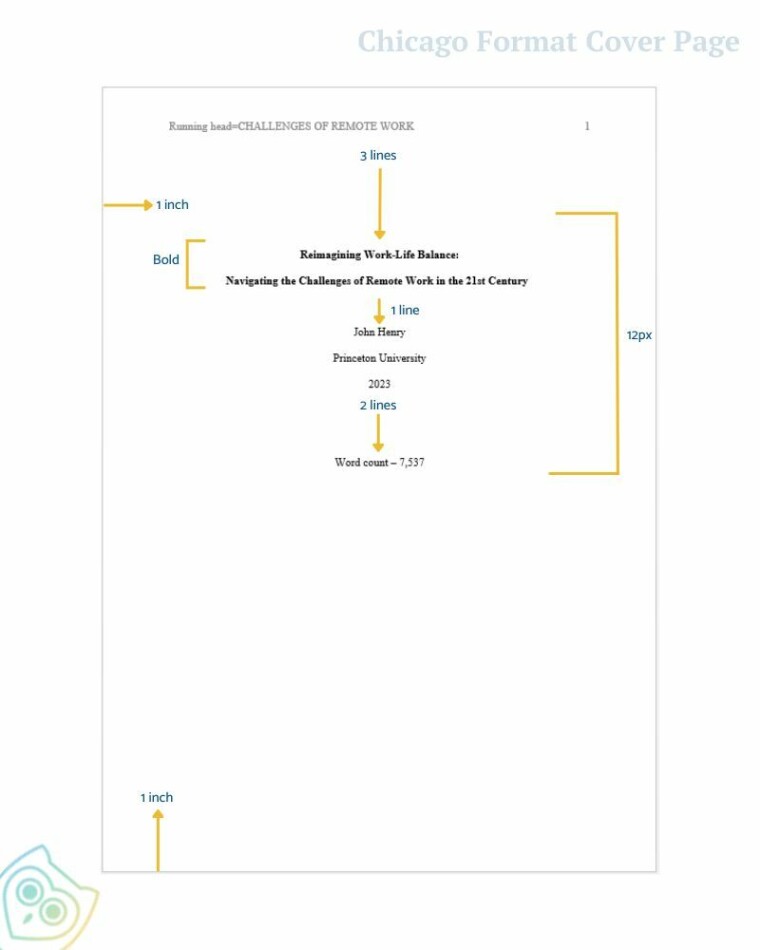
The page may also include a shortened title at the top and a page number in the header of each subsequent page. It’s essential to follow the specific structuring requirements set by your instructor or institution when creating your Chicago-style cover page. The Chicago and Turabian styles are similar in the following ways:
- Both styles typically place the title of the paper one-third to halfway down the cover page, centered horizontally;
- The title is usually in title case; the major words are capitalized;
- The author’s name is listed below the title and centered horizontally;
- The name of the institution with which the author is affiliated is often placed below the author’s name on the page;
- Both styles generally don’t include a page number on the cover page.
Additionally, endeavor to use the same font on your cover page that you use in your paper. Follow proper capitalization rules for essay titles, using uppercase for keywords and lowercase for articles and prepositions unless they begin the title. This ensures consistency and professionalism throughout your research papers; if you have more questions, you can always check PapersOwl’s page for more information.
ASA Style Cover Page
The cover page format of ASA is based on APA and includes a running head. In ASA, keep your header below 60 characters. Another distinction is that ASA mandates the inclusion of a total word count on the cover sheet, encompassing footnotes and references.
Additionally, include your name and course. List them all vertically below your name and course, if you conducted research at several institutions. Apart from these differences, all other elements follow the APA essay format .
It’s worth noting that page numbers start on the title page and must be placed in the bottom-right corner.
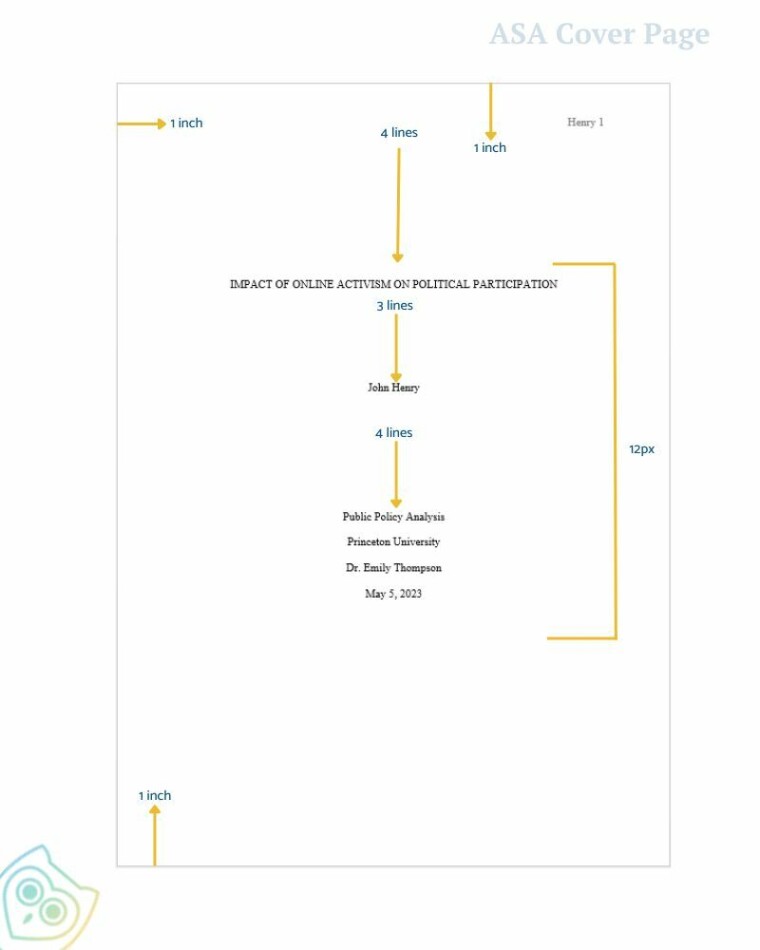
Harvard Cover Page Format
The Harvard cover page is also known as the Harvard referencing style. It is primarily used in social science and humanities disciplines, including literature, history, and economics.
The Harvard cover page example typically includes the following information, arranged in this order:
- Title of the research paper;
- Author’s name (last name, followed by the first initial);
- Date of submission;
- Course name and number;
- Name of instructor.
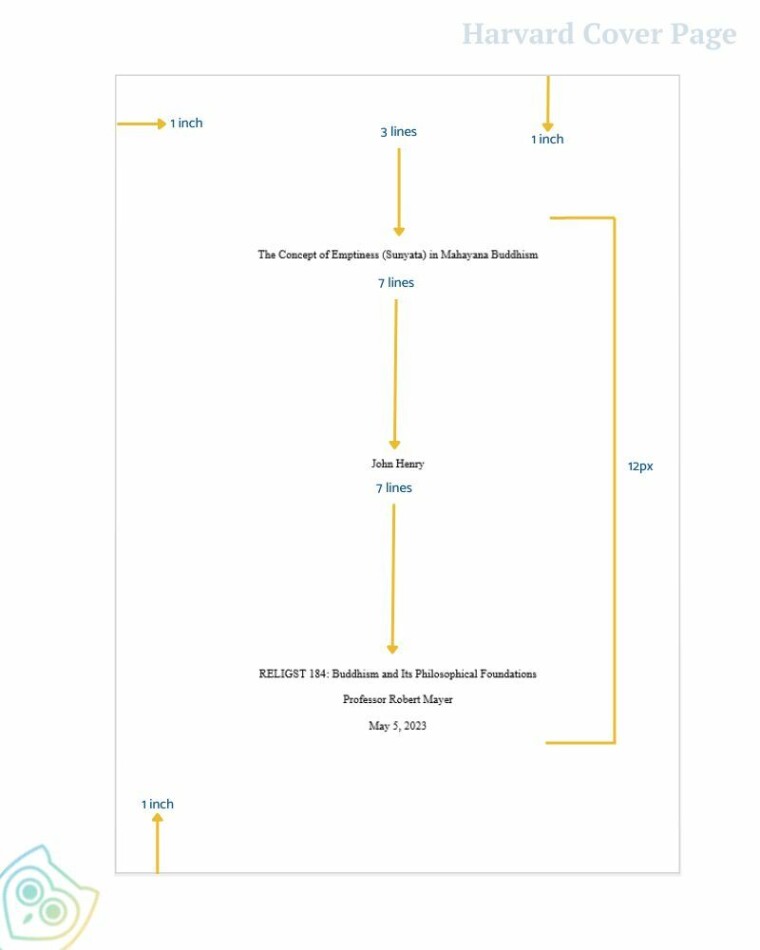
In addition to the cover page, the Harvard referencing format requires in-text citations and a reference list at the end of the document. The in-text citations include the author’s last name and year of publication, while the reference list provides complete bibliographic information for each source cited in the document.
Bottom line
Although formatting your work according to the requirements of your college might be challenging, it is vital. Undergraduate students, who sometimes take classes in several different areas at once, should be especially concerned about this. However, keep these requirements from obstructing your ability to learn. Use these suggestions to create the ideal cover page, and if you need assistance, we are always here to help. And if your professors require some changes, their instructions hold more weight than the guidelines mentioned here.
Readers also enjoyed

WHY WAIT? PLACE AN ORDER RIGHT NOW!
Just fill out the form, press the button, and have no worries!
We use cookies to give you the best experience possible. By continuing we’ll assume you board with our cookie policy.
Home / Guides / Writing Guides / Parts of a Paper / How to Write an Essay Cover Page
How to Write an Essay Cover Page
What you include in your cover page depends slightly on which citation style you are using, but the rules are generally the same.
Guide Overview
- APA cover pages
- MLA cover pages
For APA cover pages:
Include the title of the paper, running head, the author’s name, institutional affiliation, and an author’s note.
Here is an example of a cover page in APA:

For MLA cover pages:
Cover pages are not as frequently used in MLA format, as the inclusion of headers is preferred.
A header looks like this:

Cover pages can include the name of your school, your paper title, your name, your course name, your teacher or professor’s name, and the due date of the paper. If you are unsure of what to include, check with your instructor.
Here is an example of a cover page in MLA format:

For more help making cover or title pages, visit our title page generator here.
EasyBib Writing Resources
Writing a paper.
- Academic Essay
- Argumentative Essay
- College Admissions Essay
- Expository Essay
- Persuasive Essay
- Research Paper
- Thesis Statement
- Writing a Conclusion
- Writing an Introduction
- Writing an Outline
- Writing a Summary
EasyBib Plus Features
- Citation Generator
- Essay Checker
- Expert Check Proofreader
- Grammar Checker
- Paraphrasing Tools
Plagiarism Checker
- Spell Checker
How useful was this post?
Click on a star to rate it!
We are sorry that this post was not useful for you!
Let us improve this post!
Tell us how we can improve this post?
Grammar and Plagiarism Checkers
Grammar Basics
Plagiarism Basics
Writing Basics
Upload a paper to check for plagiarism against billions of sources and get advanced writing suggestions for clarity and style.
Get Started

Essay Cover Page - MLA, Chicago, Harvard, and APA Format Cover Sheet
Picture this, you have completed your daily duties and now settling in to complete an essay. What is the worst that would happen? Well, the majority of high school, college, university, and graduate students undervalue the need to format an essay cover page properly. In return, most of them end up with either great essays with a poorly done cover page or a poorly done essay with a poorly formatted cover page.
I don’t know which of the above categories, but mine was worse. It is a great mistake to care less about the proper formatting of a title page for any essay. Sometimes the content in the entire class can be great, and the cover page becomes what separates a good grade from a poor grade. You do not have to leave anything to chance when working to maintain a good GPA, do you?
Why master how to make an essay Cover Sheet?
Your title page informs the reader or the professor what to anticipate in your essay. Sometimes, if they are in a hurry, a catchy topic can entice them to read your essay from introduction to conclusion.
The cover page has your name, title of the essay, institution, instructor, and date. A well-formatted title page is enough a getaway to a strict professor’s marks or grade fountain.
And when you are almost giving up on your cover page, we give you a reason to smile. In this article, we will teach you how to make a cover page for an essay, MLA cover page format, Chicago cover page format, APA cover page format, and Harvard cover page format, with examples.
Why should you learn How to Make a Cover Page for an essay?
Sometimes professors and instructors assume the basic things like formatting a college essay. In the end, students end up losing marks over flimsy mistakes. A common question students ask is “how do you make a cover page for an essay?” or “what is to be included on a title page?”
If you have had these questions or related ones, you are in the right place at the right time. We will take you through cover page essay essentials. But before then, why do we have an essay cover page. Or simply, what is an essay cover page?
An essay cover page is the opening page, sometimes called the title page, and offers a comprehensive description of the essay title, identifies the student, and sometimes bears the date and the instructors’ names.
You will notice that the cover pages for essays differ depending on the specific format you are using. For instance, when creating the MLA essay cover page format, you should only do so if the essay prompt requires you to. If not asked for one, there is never any need to include one. The same applies to Harvard, Chicago, and APA cover page formats.
MLA Essay Cover Page Format with Template/Example
Also known as the Modern Language Association, MLA is a unique essay writing and citation format. It is important to mention that most MLA essays do not require an essay cover page. Nevertheless, some instructors insist on you having a cover page for your MLA paper.
When requested to have an opening or cover page for MLA papers, these are some of the details to include:
- Author’s Name
- Instructor’s Name
- The Due Date
Here is a sample MLA cover page template

Note that the format for MLA research paper cover page is slightly different. It will contain:
- Name of university
- Title of the Research Paper
- The subtitle of the research paper
- Your Name (Author’s Name)
- Course Name and Number
- Instructor/Professor’s Name
Below is a sample MLA research paper cover sheet
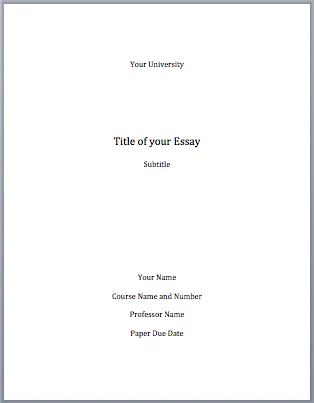
Some professors or instructors will advise you to use the research paper MLA format title page for your essay.
How do you format an MLA Cover Page?
Formatting an MLA title page is easy!
- It should be double-spaced.
- The preferable font is Times New Roman size 12 or a legible font.
- All the letters must be in Title Case.
- It should have 1-inch margins throughout the paper.
- Ensure that the title page is double spaced.
- Remove any spaces between paragraphs from your Microsoft Word settings page.
See the details in the sample MLA format cover page provided above. Notice the difference between the two and always read the instructor’s essay prompt before deciding on which one to settle for.
APA Cover Page Format with Example/Template
Students have been asking this for a while, and we felt like addressing it would save many of you out there. “How do I make an APA cover sheet?” Well, just like MLA, an APA essay cover page is easy to make.
To begin with, the APA style title page should include:
- Running head (Left aligned in the header section).
- Page Number (Right aligned).
- Title and subtitle of the essay/paper (centered)
- Name of the author (centered).
- Institutional Affiliation (centered).
- Author’s Note (for long research papers, thesis, and dissertations).
An important note, in APA the title should not exceed 50 characters and should be in capital letters. Times New Roman font size 12 is always preferred as well.
For more details, see the example APA title page provided below.

Note that there are changes to APA 6. In APA 7, there is no "Running head" instead, you will only need a page number situated to the top left of the paper. Here is a sample APA 7 Cover page.
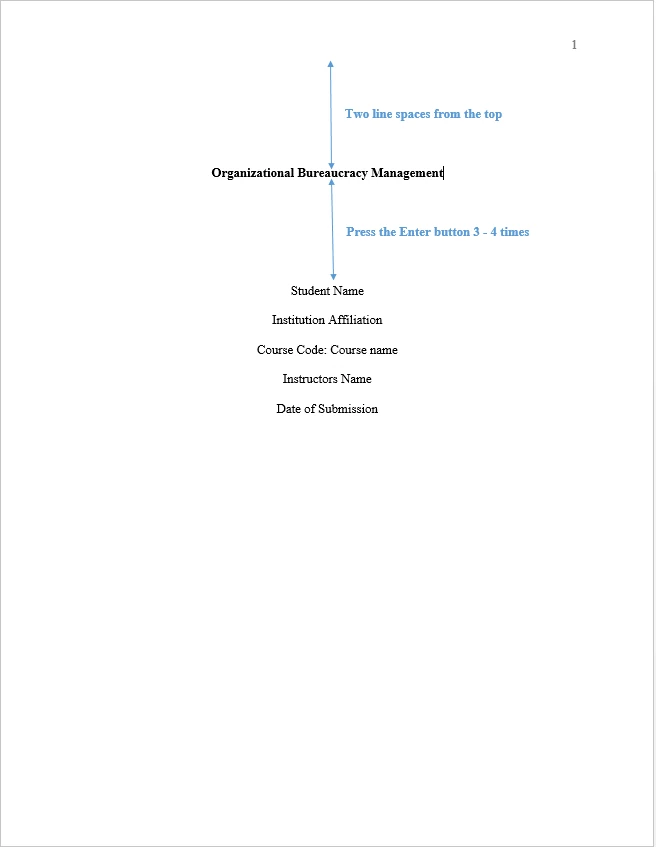
Chicago Cover Page Format with Example/Template
Even though less common in academic essay writing, understanding the Chicago essay title page is necessary. It can save you some trouble when writing a Chicago style paper, which is the case with most literature and humanities subjects such as history. Thus, after reading this, you should understand how to format a Chicago essay title cover page correctly.
Here are tips when making Chicago format opening page:
- Chicago title page has no page number or running head in the header section.
- Using Times New Roman or any legible font of size 12 is preferred.
- All the text on the cover page is centered.
- The cover page is double spaced with no spaces between paragraphs
You see, a Chicago style paper opening page is relatively simple to make. A caution, though, when making any type of cover page, your professor’s guidelines are your rule book. Therefore, everything you need to format an essay cover page is always in the prompt.
Chicago style papers are the easiest to handle. However, despite the ease of inserting a title page, it remains a challenge to most students. Sometimes, seeking professional help can be the only option. Our experts can help you craft your Chicago format essays and research papers, talk to us!
Here is a Chicago style format essay cover page.
Harvard Cover Page Format with Example/Template
Harvard formatting has a specific and well-organized cover page.
- The shortened version of the title of the paper comes in the header section (aligned to the right) and is preceded by the page number).
- The full title, written in all capital letters , appears halfway through the page.
- The author’s name (three lines from the title).
- Then four lines down you will have class name and code, name of the professor, City and State the university is located, and the due date.
Here is an example of the Harvard format Cover Sheet Page.
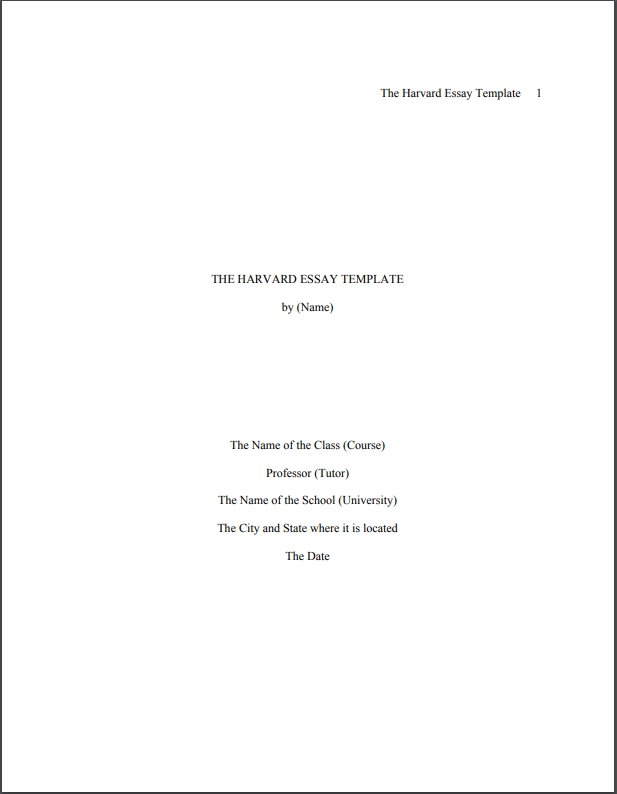
Bottom Line
A cover page for an essay is a critical aspect when undertaking your academic writing tasks. Even though it might seem boring and unnecessary, it can be the only aspect left to differentiate who passes a course and who fails.
When writing an APA, MLA, Harvard, or Chicago format paper, produce an essay cover page that fits each formatting and citation style. I don’t know about you, but I find it easier to do the cover page as the last part of the essay after writing and proofreading. Yet some in our team prefer setting the cover page for their essays first before they outline the essays . As a ritual, it is my last part to shake hands with the mighty Microsoft Word or Google Document applications.
Check out our article on indenting paragraphs and how to title an article when writing an essay.
Sometimes, you can ask the instructor or professor how to make a cover page for your essay. We believe no teacher will reprimand you. These are essential basics to keep with you as they will help you understand how to make a cover page for an essay. If you need help writing an essay, our professional writers can always come in handy. Until then, have a happy academic writing session!

Gradecrest is a professional writing service that provides original model papers. We offer personalized services along with research materials for assistance purposes only. All the materials from our website should be used with proper references. See our Terms of Use Page for proper details.

📕 Studying HQ
How to make a cover page for an essay, rachel r.n..
- May 1, 2024
- How to Guides
Creating a cover page is an important step when writing an essay, as it introduces your work and helps create a professional first impression. A cover page typically includes the title of your essay, your name, the course name/number, the instructor’s name, and the submission date. Here’s a step-by-step guide to make a cover page for your essay:
- Check your instructor’s requirements Before you start making your cover page, it’s crucial to review any specific guidelines or formatting requirements provided by your instructor. Some instructors may have precise expectations for the cover page, while others may allow more flexibility.
- Select a clean, readable font Choose a font that is easy to read and looks professional. Some recommended fonts for cover pages include:
- Times New Roman (a classic choice)
- Arial (a clean, modern font)
- Calibri (a popular sans-serif font)
Avoid using decorative or overly stylized fonts, as they can be distracting and difficult to read.
- Center your text Most cover pages have the text centered both horizontally and vertically. This creates a balanced and visually appealing layout.
- Include the necessary information Your cover page should include the following information, typically arranged in this order:
- Title of your essay (in a larger font size, bolded)
- Your full name
- Course name and number (e.g., English 101)
- Instructor’s name
- Submission date (e.g., May 1, 2024)
Here’s an example of how your cover page might look:
[Title of Your Essay]
John Doe English 101: Introduction to Literature Prof. Jane Smith May 1, 2024
- Add spacing and margins Use appropriate spacing between each line of text to improve readability. A common approach is to add a blank line between the title and your name, and between the other lines of information.
Additionally, leave sufficient margins (typically 1 inch) around the edges of the page to create a clean and professional look.
- Consider adding a header or footer (optional) Some instructors may require or prefer that you include a header or footer with your name and the page number on the cover page. If so, make sure to follow their specific guidelines.
- Double-check for accuracy Before submitting your essay, carefully review your cover page to ensure that all the information is accurate and correctly formatted. This includes checking for spelling errors, proper capitalization, and consistent formatting.
What You'll Learn
APA Format Cover Page:
- The title of your essay should be centered, bolded, and in title case on the first line of the cover page.
- On the next line, include your name (first name, middle initial, last name).
- On the next line, include your school or university’s name.
- On the next line, include the course number and name.
- On the next line, include your instructor’s name.
- On the next line, include the assignment due date.
- Use 1-inch margins and a readable font like Times New Roman (12pt) or Arial (11pt).
- Double-space the entire cover page.
Jane Q. Student Awesome University ENGL 101: Introduction to Literature Dr. John Smith May 1, 2024
Related Article: Updated APA 7 Format and Citation Guide
Chicago Format Cover Page:
- The title of your essay should be centered and in title case on the first line of the cover page.
- Approximately one-third of the way down the page, include your full name.
- Use 1-inch margins and a readable font like Times New Roman (12pt).
Jane Q. Student ENGL 101: Introduction to Literature Dr. John Smith May 1, 2024
Related Article: Chicago-Style Citation Quick Guide
MLA Format Cover Page:
- On the next line, include your full name.
- On the next line, include the course name.
Jane Q. Student Dr. John Smith Introduction to Literature May 1, 2024
Related article: Guide to correct MLA 8 Citation and Referencing
Start by filling this short order form order.studyinghq.com
And then follow the progressive flow.
Having an issue, chat with us here
Cathy, CS.
New Concept ? Let a subject expert write your paper for You
Have a subject expert write for you now, have a subject expert finish your paper for you, edit my paper for me, have an expert write your dissertation's chapter, popular topics.
Business StudyingHq Essay Topics and Ideas How to Guides Samples
- Nursing Solutions
- Study Guides
- Free College Essay Examples
- Privacy Policy
- Writing Service
- Discounts / Offers
Study Hub:
- Studying Blog
- Topic Ideas
- Business Studying
- Nursing Studying
- Literature and English Studying
Writing Tools
- Citation Generator
- Topic Generator
- Paraphrasing Tool
- Conclusion Maker
- Research Title Generator
- Thesis Statement Generator
- Summarizing Tool
- Terms and Conditions
- Confidentiality Policy
- Cookies Policy
- Refund and Revision Policy
Our samples and other types of content are meant for research and reference purposes only. We are strongly against plagiarism and academic dishonesty.
Contact Us:
📞 +15512677917
2012-2024 © studyinghq.com. All rights reserved

The Plagiarism Checker Online For Your Academic Work
Start Plagiarism Check
Editing & Proofreading for Your Research Paper
Get it proofread now
Online Printing & Binding with Free Express Delivery
Configure binding now
- Academic essay overview
- The writing process
- Structuring academic essays
- Types of academic essays
- Academic writing overview
- Sentence structure
- Academic writing process
- Improving your academic writing
- Titles and headings
- APA style overview
- APA citation & referencing
- APA structure & sections
- Citation & referencing
- Structure and sections
- APA examples overview
- Commonly used citations
- Other examples
- British English vs. American English
- Chicago style overview
- Chicago citation & referencing
- Chicago structure & sections
- Chicago style examples
- Citing sources overview
- Citation format
- Citation examples
- College essay overview
- Application
- How to write a college essay
- Types of college essays
- Commonly confused words
- Definitions
- Dissertation overview
- Dissertation structure & sections
- Dissertation writing process
- Graduate school overview
- Application & admission
- Study abroad
- Master degree
- Harvard referencing overview
- Language rules overview
- Grammatical rules & structures
- Parts of speech
- Punctuation
- Methodology overview
- Analyzing data
- Experiments
- Observations
- Inductive vs. Deductive
- Qualitative vs. Quantitative
- Types of validity
- Types of reliability
- Sampling methods
- Theories & Concepts
- Types of research studies
- Types of variables
- MLA style overview
- MLA examples
- MLA citation & referencing
- MLA structure & sections
- Plagiarism overview
- Plagiarism checker
- Types of plagiarism
- Printing production overview
- Research bias overview
- Types of research bias
- Example sections
- Types of research papers
- Research process overview
- Problem statement
- Research proposal
- Research topic
- Statistics overview
- Levels of measurment
- Frequency distribution
- Measures of central tendency
- Measures of variability
- Hypothesis testing
- Parameters & test statistics
- Types of distributions
- Correlation
- Effect size
- Hypothesis testing assumptions
- Types of ANOVAs
- Types of chi-square
- Statistical data
- Statistical models
- Spelling mistakes
- Tips overview
- Academic writing tips
- Dissertation tips
- Sources tips
- Working with sources overview
- Evaluating sources
- Finding sources
- Including sources
- Types of sources
Your Step to Success
Plagiarism Check within 10min
Printing & Binding with 3D Live Preview
Cover Page – APA, MLA & Chicago Style With Examples
How do you like this article cancel reply.
Save my name, email, and website in this browser for the next time I comment.
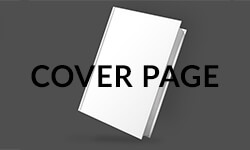
In the academic and professional realms, the presentation of written work is nearly as crucial as the content itself. The most popular guidelines are the APA, MLA, and Chicago style. Each has its unique specifications and nuances, particularly when it comes to crafting the cover page , a pivotal aspect that provides the first impression of any document. This article delves into the distinct features and requirements with examples .
Inhaltsverzeichnis
- 1 Cover page in a nutshell
- 2 Definition: Cover page
- 3 When is a cover page used?
- 4 Essentials of a cover page
- 6 Cover page for students
Cover page in a nutshell
What is a cover page? A cover page is also called the title page and is the first page of an academic essay or other kinds of academic papers. It displays its title, the author’s name, and other relevant information, serving as an introduction or a preview of what’s inside. Think of it like the cover of a book, giving a glimpse of what the content is about.
Definition: Cover page
The cover page serves as a representation of the author. The format will differ based on the style you choose. It typically contains:
- Name of the author
- Name of the professor
- Name of the student’s educational establishment
- Due date of the paper
The topic of the paper and the course name are always included on the title page, regardless of the format used. As the name suggests, it is placed at the front of the paper and is the first thing your professor will see when they receive your paper. When writing an academic paper, you have to adhere to certain established standards. A cover page is required for many papers, as it introduces the professor to the project. In this article, we will look at the different types and their formats.

When is a cover page used?
A cover page is used in various academic, professional, and publishing contexts to provide a clear and organized introduction to a document. Its usage can vary based on the style guide in reference. Here’s a brief overview of when it is used in APA, MLA, and Chicago styles .
- APA style always requires a title page for both student papers and professional articles or studies. You can read more in our article about the APA format title pages.
- Title of the paper, author’s name, institutional affiliation, course name and number (for students), instructor’s name (for students), and due date
- MLA style does not typically require a title page for research papers , unless specifically requested by the instructor. Instead, essential details are usually placed in the top-left corner of the first page.
- Title, name of the author, instructor’s name, course, and date
Chicago style
- Its usage depends on specific publication or institutional requirements. For formal publications and individual assignments, a title page is typically preferred.
- Title, author’s name, often the specific class or course information, and date of submission
Essentials of a cover page
A cover page requires:
- A running head
- The title of your academic paper
- The name of your university
- The name of the author or authors
Besides these requirements, your professor may ask you to add extra information . As mentioned earlier, you should refer to the latest guidelines to see how the cover should be formatted. With APA style, you have to use 12-point Times New Roman font, double-spacing, and 1-inch margins.
The running head has to be left-aligned, and it should be capitalized. Besides the ‘running head,’ your header should have a maximum of 50 characters.
The title of your paper should also be properly formatted. It should be in the title case, meaning the first letters of every word is capitalized. The only words that should not be capitalized are small words like articles and prepositions . The title should be no more than 12 words in length. For the title, you should use whole words only. Avoid contractions and abbreviations.
The names of the authors should also be properly formatted. If multiple authors were involved in writing the paper, they should all be mentioned, along with the institutions they are affiliated with. Students with different affiliations should be listed separately.
The cover page should not be spruced up unnecessarily. Its only objective is to provide the reader or professor with essential information. Don’t use colored paper, colored text, or fancy images to make it look more attractive. That will only make you appear less professional.
There are as many kinds of cover pages as there are academic writing formats. The most commonly used cover page formats are MLA , APA , and Chicago . The difference lies in their format and content. Here is an overview of each of these types.
APA cover page
The APA format cover page should start with the running head, positioned at the top left of your paper. The page number is on the top right. Your paper title is to be in title case, in the upper half of the page. For the title, you simply respect the rules for capitalization in titles . APA recommends that your title should be 12 words in length or less, and it should not include any abbreviations or contractions. Words that serve no purpose should also be left out. The title can take up one or two lines.
The information for an APA format cover is below the title of your paper, then the names of the authors and their institutional affiliations are listed. The author’s name should include first name, middle initial(s), and last name. The titles of the author(s) and their educational qualifications should not be included in this part of the paper. The institutional affiliation is included under the author’s name, and it shows where the researcher carried out the research.
For more information, read our article about the APA cover page .
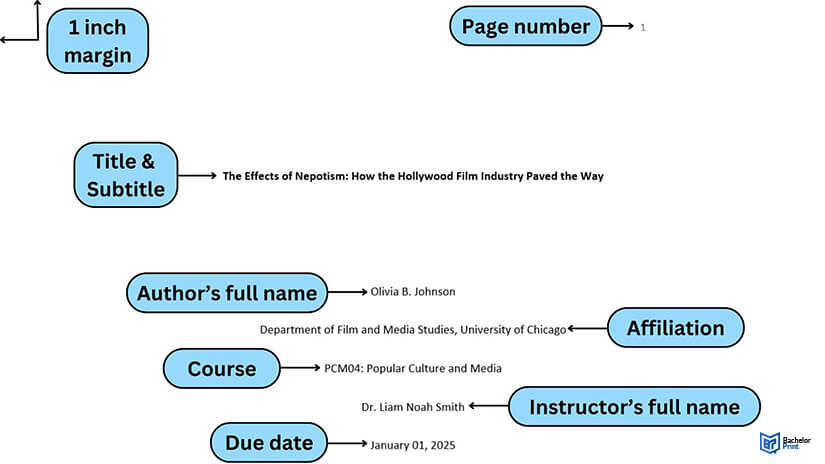
MLA cover page
When using an MLA format cover page, it is not required. Your instructor will let you know whether they require a cover. For some assignments, a cover can make your paper look more professional, so you should always consider adding one. For MLA, you will have to include:
- School or university name
- Title of your paper
- Name of the class
- Name of your professor
- Date of submission
Note: Different instructors may have different style requirements. You may need to add other details to the cover page.
Like in APA, the format cover page is double-spaced and the letters are centered on the page. The name of your university should be typed first, after which you can skip down to a third of the page and add the title of the research paper. From here, you can skip several lines and add the rest of the details. These details should be on the bottom half of the page.
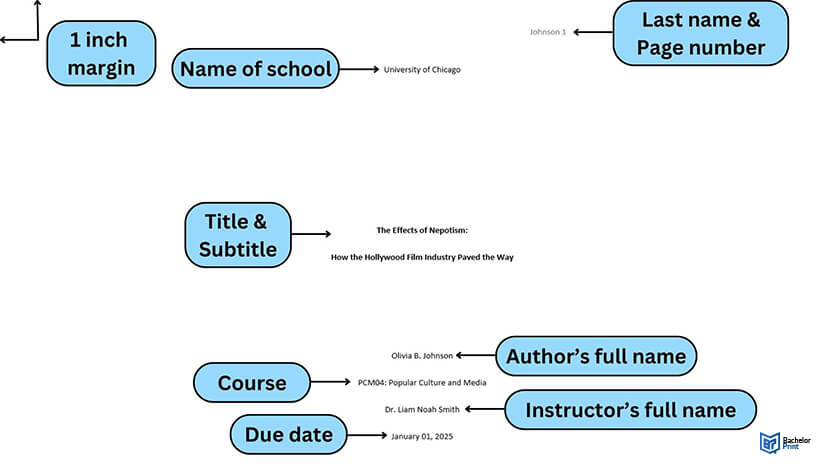
Chicago style cover page
Usually, the Chicago style does not require a cover. However, they may be requested for individual assignments. In this case, the Chicago cover page includes the title of your page, the name of the author, the name of your teacher, the course title, and the due date. The title should be typed at about one-third of the way down the page. Some professors accept covers using 11 pt. Arial font, but the most widely used font is 12 pt. Times New Roman. You should generally avoid using fancy fonts or underlining the text. You can only use bold for the title and subtitle. The page should be double-spaced. The page number should not be included in a Chicago style cover page.
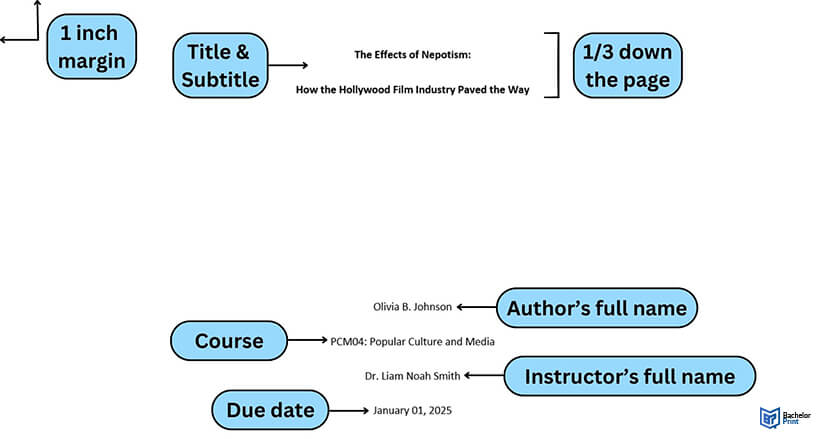
Cover page for students
Creating a student cover page involves considering the essential elements that offer a concise overview of the work, while also adhering to any style or formatting guidelines in place. Here’s a general outline of what should be included.
- Title of the document/paper Ideally placed at the center of the page Should be specific and concise, capturing the essence of the paper
- Student’s name Usually positioned under the title Full name is recommended unless specified otherwise
- Course name and code Essential for academic submissions to ensure the paper reaches the correct instructor or department
- Instructor/professor’s name Specify the honorific title (e.g., Dr., Prof.) if applicable
- Date of submission Can be written in different formats (e.g., September 21, 2023, or 21-09-2023) depending on institutional or style guide preferences
- Institution Name Name of the school, college, or university
- Class or section If applicable Especially useful for larger courses with multiple sections
- Assignment number or type Optional E.g., “Assignment 1”, “Final Project”, “Research Paper”, etc.
Formatting tips
Use a readable font like Times New Roman, Arial, or Calibri. Typically, a 12 pt. font size is recommended. Details on the cover are usually double-spaced for clarity. Ensure you have standard margins (typically 1 inch, so 2.54 cm, on all sides) unless specified otherwise by your institution or style guide. Most of the details are typically centered on the page, but some style guides might have different requirements. Always refer to specific institutional guidelines or the requested style guide (e.g., APA, MLA, Chicago) as they may have distinct stipulations for page composition.
How do you write a title page for an essay?
The title page of your academic essay should be simple and straightforward, and it should only consist of text. For the cover page design, you should consult the latest manual of your institution. You may be required to use a certain style of formatting, such as APA, or MLA. The requirements for an APA title page differ from the requirements of an MLA title page .
Does the title page count as one page?
The title page will take up a whole page of your essay. However, it does not count as one page in terms of the page count for your essay . The table of contents and bibliography are also not included in the word/page count of your essay.

How do you format the names of multiple authors?
If more than one person was involved in writing the paper, all the names should be clearly indicated. The format used will depend on the affiliations of the authors and the institution that they’re working with. For an APA cover page, the authors should be listed below the title of the paper. List their first names, middle initials, and last names with any titles and qualifications.
Is a cover page always required?
The cover page is typically required when you use the APA citation style. With the MLA and Chicago formats, your instructor will advise you on whether you have to include a cover. However, more often than not, MLA formatting does not require a title page.
Will you be penalized for adding a cover page when it is not required?
No instructor will penalize you for including a cover page when it is not strictly required. You should consider adding one if you are uncertain whether it is required for your academic writing work. Nevertheless, you should check with your institution anyway to ensure that you’re fulfilling all requirements.
We use cookies on our website. Some of them are essential, while others help us to improve this website and your experience.
- External Media
Individual Privacy Preferences
Cookie Details Privacy Policy Imprint
Here you will find an overview of all cookies used. You can give your consent to whole categories or display further information and select certain cookies.
Accept all Save
Essential cookies enable basic functions and are necessary for the proper function of the website.
Show Cookie Information Hide Cookie Information
Statistics cookies collect information anonymously. This information helps us to understand how our visitors use our website.
Content from video platforms and social media platforms is blocked by default. If External Media cookies are accepted, access to those contents no longer requires manual consent.
Privacy Policy Imprint

Free Cover Page templates
Create impressive cover pages for your assignments and projects online in just a click. choose from hundreds of free templates and customize them with edit.org..
Create impressive cover pages in a few minutes with Edit.org, and give your projects and assignments a professional and unique touch. A well-designed title page or project front page can positively impact your professor's opinion of your homework, which can improve your final grade!

Create a personalized report cover page
After writing the whole report, dissertation, or paper, which is the hardest part, you should now create a cover page that suits the rest of the project. Part of the grade for your work depends on the first impression of the teacher who corrects it.
We know not everyone is a professional designer, and that's why Edit.org wants to help you. Having a professional title page can give the impression you've put a great deal of time and effort into your assignment, as well as the impression you take the subject very seriously. Thanks to Edit.org, everyone can become a professional designer. This way, you'll only have to worry about doing a great job on your assignment.
On the editor, you will also find free resume templates and other educational and professional designs.

Customize an essay cover page with Edit.org
- Go to formats on the home page and choose Cover pages.
- Choose the template that best suits the project.
- You can add your images or change the template background color.
- Add your report information and change the font type and colors if needed.
- Save and download it. The cover page is ready to make your work shine!

Free editable templates for title pages
As you can see, it's simple to create cover pages for schoolwork and it won’t take much time. We recommend using the same colors on the cover as the ones you used for your essay titles to create a cohesive design. It’s also crucial to add the name and logo of the institution for which you are doing the essay. A visually attractive project is likely to be graded very well, so taking care of the small details will make your work look professional.
On Edit.org, you can also reuse all your designs and adapt them to different projects. Thanks to the users' internal memory, you can access and edit old templates anytime and anywhere.

Take a look at other options we propose on the site. Edit.org helps design flyers, business cards, and other designs useful in the workplace. The platform was created so you don't need to have previous design knowledge to achieve a spectacular cover page! Start your cover page design now.
Create online Cover Pages for printing
You can enter our free graphic editor from your phone, tablet or computer. The process is 100% online, fun and intuitive. Just click on what you want to modify. Customize your cover page quickly and easily. You don't need any design skills. No Photoshop skills. Just choose a template from this article or from the final waterfall and customize it to your liking. Writing first and last names, numbers, additional information or texts will be as easy as writing in a Word document.
Free templates for assignment cover page design

Tumblr Banners

Album Covers
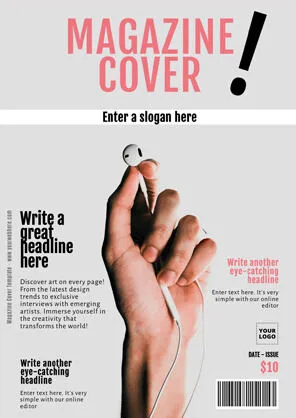
Magazine Covers

Book & eBook Covers
- PRO Courses Guides New Tech Help Pro Expert Videos About wikiHow Pro Upgrade Sign In
- EDIT Edit this Article
- EXPLORE Tech Help Pro About Us Random Article Quizzes Request a New Article Community Dashboard This Or That Game Popular Categories Arts and Entertainment Artwork Books Movies Computers and Electronics Computers Phone Skills Technology Hacks Health Men's Health Mental Health Women's Health Relationships Dating Love Relationship Issues Hobbies and Crafts Crafts Drawing Games Education & Communication Communication Skills Personal Development Studying Personal Care and Style Fashion Hair Care Personal Hygiene Youth Personal Care School Stuff Dating All Categories Arts and Entertainment Finance and Business Home and Garden Relationship Quizzes Cars & Other Vehicles Food and Entertaining Personal Care and Style Sports and Fitness Computers and Electronics Health Pets and Animals Travel Education & Communication Hobbies and Crafts Philosophy and Religion Work World Family Life Holidays and Traditions Relationships Youth
- Browse Articles
- Learn Something New
- Quizzes Hot
- This Or That Game
- Train Your Brain
- Explore More
- Support wikiHow
- About wikiHow
- Log in / Sign up
- Job Application Documents
- Resume Preparation
How to Make a Cover Page
Last Updated: January 12, 2024 Fact Checked
This article was co-authored by Amber Rosenberg, PCC . Amber Rosenberg is a Professional Life Coach, Career Coach, and Executive Coach based in the San Francisco Bay Area. As the owner of Pacific Life Coach, she has 20+ years of coaching experience and a background in corporations, tech companies, and nonprofits. Amber trained with the Coaches Training Institute and is a member of the International Coaching Federation (ICF). There are 7 references cited in this article, which can be found at the bottom of the page. This article has been fact-checked, ensuring the accuracy of any cited facts and confirming the authority of its sources. This article has been viewed 145,242 times.
Many professional and academic documents will require a cover page, but the information required for a cover page varies depending on the nature of the document. Some cover pages, like those you would send with a resume, are actually letters. Others, like those used for academic essays, are actually title pages. For all cover letters, using a standard font such as Times New Roman, in at least a 12-point size, is recommended.
Formatting a Cover Page For Your Resume

- You should usually use standard 1-inch (2.5-cm) margins, but you can use margins as small as 0.7 inch (1.8 cm) as long as they are the same on all sides.

- If you have a fax number, you should include it below your phone number and above your e-mail address.

- Write out the full name of the month, rather than abbreviating by using a number. For example, rather than write 1/1/2001, you should write January 1, 2001.
- Leave a blank line above and below the date.

- Note that you do not need to include an e-mail address, phone number, or fax number for the company.
- If you do not know the name of a specific contact at the company, skip over that information.

- When you can determine the gender of the receiver, leave out his or her first name and address the receiver as "Mr." or "Ms." For example, "Dear Ms. Smith" or "Dear Mr. Johnson."
- If you do not know the gender of the receiver, skip the title and use his or her full name. For example, "Dear Pat Roberts."
- Leave a blank line before and after you address the receiver.

- If you are a student, state the university you attend and your major.
- Indicate what position you are applying for as well as how or where you heard about the position.
- You can also mention the name of a professional or academic contact you know who has a positive connection to the reader or company.

- List any special projects, awards, or accomplishments that have a clear connection to the skill set requested by the employer.

- You can include your phone number and e-mail address, as well, but it is not entirely necessary since this information is included in your header.

- Always use black ink to sign formal documents.
Making a Cover Page For a Fax

- Include your phone number and your fax number beneath your name and address.
- Leave at least two blank lines below this header and the rest of the document.

- It's a good idea to save your document as a template for future fax use, since the general format will remain the same.
- The most important quality to your fax cover sheet is that it be clear and easy to read.

- Label the date with "DATE," the receiver's name with "TO," your name with "FROM," and your phone number with "PHONE."
- In the United States, the date will be written in "Month, Day, Year," while in most other countries, it will be written "Day, Month, Year."

- Label the time with "TIME," the receiver's fax number with "FAX," your fax number with "FAX," and your e-mail address with "EMAIL."
- Note that the receiver's name and fax number should be placed on the same horizontal line. Likewise, your name and fax number should be placed on a shared horizontal line of their own.

- Note that this line does not need to be in all capital letters.

- If you had previous contact with the receiver concerning this fax, state that information.
- Introduce your message with the label "MESSAGE:"
- Below your message, ask the receiver to verify the receipt of the document by calling the phone number provided or using the e-mail address provided.

- Specific privacy guidelines for transmission of protected confidential information may vary. If you work for a health provider, you may need to follow additional guidelines to protect the privacy of your client.
Formatting a Cover Page For Your Manuscript

- Use your real name. If you are submitting the manuscript under a pen name, you can follow your real name with your pen name. Introduce a pen name with "A.K.A." or "(Pen name: John Doe)."
- If you're submitting your work to a context that will be judged anonymously, you'll include your contact information on the cover page, while omitting your name and contact information from the title page.

- You do not need to use an exact word count. For instance, if your manuscript is 63,472 words, round it off to 63,000 or 63,500.
- Introduce the word count with "Approximately ______ words."

- Typing the title in all capital letters is a fairly common practice, but it is not necessary.
- It's not necessary to underline, italicize, or bold the title.

- You don't have to include any indication of copyright protection, as your work is automatically protected.
- Never bind or connect the pages of your manuscript in any way. Your cover letter, like the other pages of your manuscript, should be unbound and placed in an envelope or box.
Using APA Style For Your Cover Page

- Introduce the running head with the words "Running head." Follow this label with a colon.
- The running head itself should be in all capital letters.
- The running head should be no longer than 50 characters, including spaces and punctuation.

- The page number and running head should be evenly aligned horizontally.

- Capitalize the first letter of all major words but not for minor words. For example: How to Make a Cover Page
- Do not italicize, bold, or underline the title.

- For example, if you are submitting the paper for a class taken at the University of North Carolina at Asheville, you should include this in the line beneath the author's name (i.e. your name, and the names of your co-authors.)
- Check with your professor for any additional guidelines.
Using MLA Style For Your Cover Page

- Be aware that cover pages are not standard in MLA format, but some professors do request them.

- Do not bold, italicize, or underline either the title or the subtitle.

- Your name should be written using the same font and size as the other words on your title page.
- Don't try to use a cute or clever font for any part of your cover page, as professors don't care for this.

- Introduce your instructor as "Dr." when appropriate. If you cannot use this title to address your instructor, at least introduce him or her as "Professor." For example, "Dr. John Doe" or "Professor John Doe."
- Include both the course name and number.
Using Chicago Style For Your Cover Page
- In Chicago style, cover page and title page refer to the same thing.
- Your professor may have other requirements. Make sure you use the preferred formatting for your course.

- Capitalize the first letter of each major word in your title, but not those belonging to minor words. For example: How to Make a Cover Page
- Alternatively, some style guides suggest that the title be presented in ALL CAPS.
- Do not underline, italicize, or bold the title.
- If you have a subtitle, place a colon following your title and write the subtitle on the following line.

- Your name should be typed about three quarters of the way down the page.
- Use the same font and size that you've used throughout the cover page.

- Include both the name and course number of the subject.
- Write your professor's full name and title. Use "Dr." only when appropriate. For example: "Dr. John Doe" or "Professor John Doe."
Expert Q&A

You Might Also Like

- ↑ https://careercenter.georgetown.edu/major-career-guides/resumes-cover-letters/resume-formatting-tips/
- ↑ Amber Rosenberg, PCC. Pacific Life Coach. Expert Interview. 8 March 2022.
- ↑ http://owl.english.purdue.edu/owl/resource/549/01/
- ↑ http://windows.microsoft.com/en-us/windows/create-edit-fax-cover-page#1TC=windows-7
- ↑ https://winningwriters.com/resources/manuscript-tips
- ↑ http://academictips.org/mla-format/mla-format-cover-page/
- ↑ https://owl.english.purdue.edu/owl/resource/717/02/
About This Article

To make a cover page using MLA format, start by setting your margins to 1 inch on all sides and keeping the alignment centered. Next, choose 12 point Times New Roman for your font and place your title roughly one-third of the way down, capitalizing the first letter of every major word in your title. Then, skip several lines below the title and write your full name, as well as any other collaborators. Finally, list the name of your instructor, the name of the class, and the date, making sure to separate each element with a double-spaced line. To learn more, like how to make a cover page using APA or Chicago Style, read on! Did this summary help you? Yes No
- Send fan mail to authors
Did this article help you?

Featured Articles

Trending Articles

Watch Articles

- Terms of Use
- Privacy Policy
- Do Not Sell or Share My Info
- Not Selling Info
wikiHow Tech Help Pro:
Develop the tech skills you need for work and life
APA Title Page (Cover Page) Format, Example, & Templates
Saul Mcleod, PhD
Editor-in-Chief for Simply Psychology
BSc (Hons) Psychology, MRes, PhD, University of Manchester
Saul Mcleod, PhD., is a qualified psychology teacher with over 18 years of experience in further and higher education. He has been published in peer-reviewed journals, including the Journal of Clinical Psychology.
Learn about our Editorial Process
Olivia Guy-Evans, MSc
Associate Editor for Simply Psychology
BSc (Hons) Psychology, MSc Psychology of Education
Olivia Guy-Evans is a writer and associate editor for Simply Psychology. She has previously worked in healthcare and educational sectors.
On This Page:
In APA Style (7th edition), the cover page, or title page, should include:
- A running head (professional papers only) and page number
- The title of the paper
- The name of the author(s)
- The institutional affiliation
- An author note; optional (professional papers only)
- A student paper should also include course information
Note : APA 7 provides slightly different directions for formatting the title pages of professional papers (e.g., those intended for scholarly publication) and student papers (e.g., those turned in for credit in a high school or college course).
Professional paper APA title page

Student paper APA title page

Formatting an APA title page
Note : All text on the title page should be double-spaced and typed in either 12-point, Times New Roman font. In the 7th edition, APA increaded the flexibility regarding font options: which now include Calibri 11, Arial 11, Lucida Sans Unicode 10, Times New Roman 12, or Georgia 11. All words should be centered, and capitalize the first letter of important words.
Running Head
In the 7th edition of the APA style manual, running heads are only required for professional papers that are being submitted for publication (student papers do not require a running head, but still need a page number).
Your title page should contain a running head that is flush left at the top of the page and a page number that is flush right at the top of the page.
Place the running head in the page’s header:
- The running head is the abbreviated title of the paper (IN UPPERCASE LETTERS) aligned left on the page header of all pages, including the title page. APA (7th edition) guidelines require that running heads be a maximum of 50 characters (spaces count as characters).
- The “Running head:” label used in the APA sixth edition is no longer used.
- Place the page number in this same header, but align right, beginning with page number 1 on the title page.
- This header should be 1 inch from the top. Some instructors allow for 1/2 inch, too, but the default is 1 inch.
Paper Title
Position the title of the paper in the upper half of the page. The title should be centered and written in boldface, and important words should be capitalized.
The APA recommends that your title should be a maximum of 12 words and should not contain abbreviations or words that serve no purpose.
Author Name(s)
Institutional affiliation.
Position the school or university’s name below the author(s) name, centered.
A student paper should also include the course number and name, instructor name, and assignment due date.
Further Information
- APA Student Title Page Guide
- APA Referencing
- How to Write a Lab Report
- Essay Writing Guide for Psychology Students
- APA Style Citations & References
- Example of an APA Formatted Paper
- Skip to main content
- Skip to secondary menu
- Skip to primary sidebar
- Skip to footer
Erin Wright Writing
Writing-Related Software Tutorials
How to Create a Cover Page in Microsoft Word (Built-In and Custom)
By Erin Wright
This tutorial shows how to create a cover page in Microsoft Word. First, we’ll create a cover page using a built-in design. Then, we’ll create a custom cover page that can be reused. Next, we’ll delete a cover page. Plus, the bonus section at the end shows how to remove page number zero from a cover page.
Quick Links:
- How to Create a Built-In Cover Page
How to Create a Custom Cover Page
- How to Delete a Cover Page
How to Remove Page Number Zero from a Cover Page
This tutorial is also available as a YouTube video showing all the steps in real time.
Watch more than 250 other writing-related software tutorials on my YouTube channel .
The images below are from Word for Microsoft 365 on a PC. These steps will also work in Word 2021, Word 2019, Word 2016, Word 2013, and Word 2010. However, your interface may look slightly different in those older versions of the software.
How to Create a Built-In Cover Page in Microsoft Word
You can quickly create a cover page using a built-in design.
- Select the Insert tab in the ribbon.

- Select Cover Page in the Pages group.

- Choose a built-in design from the gallery in the drop-down menu. (Hover over More Cover Pages from Office.com for additional options.)

- (Optional) To insert your cover page somewhere other than the top of your document, right-click the built-in design, and then choose a location from the shortcut menu.

- Place your cursor in the sample text, and then type your information.

Pro Tip: To delete a section of sample text, right-click it, and then select Remove Content Control from the shortcut menu.

The built-in cover page should now be part of your Word document.
You can create a custom cover page that can be reused in other Word documents.
- Open a blank document. ( Pro Tip: Press Ctrl + N to open a blank document.)
- Create your cover page, including images if necessary.
- Select all the text and images that should be included in the cover page.

- Select the Insert tab in the ribbon (see figure 1).
- Select Cover Page in the Pages group (see figure 2).
- Select Save Selection to Cover Page Gallery from the drop-down menu.

- Type a unique name into the Name text box in the Create New Building Block dialog box. (Cover pages are part of Word’s building block system of reusable content.)

- (Optional) Add additional information into the Description text box, if necessary.
Important Note: I strongly recommend leaving the default settings for the other options in this dialog box.
- Select the OK button.

Your custom cover page should now be added to the Cover Page Gallery.
- Close the document used to create your custom cover page. (You don’t have to save this document.)
- Select Save in the alert box asking if you want to save changes to Building Blocks.dotx.

- Open the document to which you want to add the custom cover page.
- Select the Insert tab (see figure 1).
- Select your custom cover page from the gallery.

Your custom cover page should now be added to your current document.
Pro Tip: How to Delete a Custom Cover Page from the Cover Page Gallery
- Right-click the custom cover page in the Cover Page drop-down menu, and then select Organize and Delete from the shortcut menu.

Caution: Your custom cover page will be automatically selected when the Building Blocks Organizer dialog box opens. Take care not to select another item.
- Select the Delete button in the Building Blocks Organizer dialog box.

- Select the Yes button in the question dialog box asking if you are sure you want to delete the selected building block.

- Select the Close button in the Building Blocks Organizer dialog box.

Your custom cover page should now be removed from the Cover Page Gallery.
How to Delete a Cover Page in Microsoft Word
The following steps show how to remove a cover page from an individual document.
- Select Remove Current Cover Page from the drop-down menu.

Your cover page should be removed from your document.
If your document has page numbers, the page number zero may show up unnecessarily on the cover page. The following steps show how to remove page number zero.
- Double-click the top of any page to open the Header & Footer tab.

- Select Different First Page in the Options group.

- Select the Close Header and Footer button.

The page number zero should now be removed from your cover page.
Related Resources
How to Insert Citations in Microsoft Word
How to Create a Citation with Multiple Sources in Microsoft Word
How to Insert Footnotes and Endnotes in Microsoft Word
Updated July 02, 2023
- Microsoft Word Tutorials
- Adobe Acrobat Tutorials
- PowerPoint Tutorials
- Writing Tips
- Editing Tips
- Writing-Related Resources
Purdue Online Writing Lab Purdue OWL® College of Liberal Arts
Welcome to the Purdue Online Writing Lab

Welcome to the Purdue OWL
This page is brought to you by the OWL at Purdue University. When printing this page, you must include the entire legal notice.
Copyright ©1995-2018 by The Writing Lab & The OWL at Purdue and Purdue University. All rights reserved. This material may not be published, reproduced, broadcast, rewritten, or redistributed without permission. Use of this site constitutes acceptance of our terms and conditions of fair use.
The Online Writing Lab at Purdue University houses writing resources and instructional material, and we provide these as a free service of the Writing Lab at Purdue. Students, members of the community, and users worldwide will find information to assist with many writing projects. Teachers and trainers may use this material for in-class and out-of-class instruction.
The Purdue On-Campus Writing Lab and Purdue Online Writing Lab assist clients in their development as writers—no matter what their skill level—with on-campus consultations, online participation, and community engagement. The Purdue Writing Lab serves the Purdue, West Lafayette, campus and coordinates with local literacy initiatives. The Purdue OWL offers global support through online reference materials and services.
A Message From the Assistant Director of Content Development
The Purdue OWL® is committed to supporting students, instructors, and writers by offering a wide range of resources that are developed and revised with them in mind. To do this, the OWL team is always exploring possibilties for a better design, allowing accessibility and user experience to guide our process. As the OWL undergoes some changes, we welcome your feedback and suggestions by email at any time.
Please don't hesitate to contact us via our contact page if you have any questions or comments.
All the best,
Social Media
Facebook twitter.

IMAGES
VIDEO
COMMENTS
A cover page serves as a formal introduction for academic research, corporate proposals, and job application letters. It's seldom used for essays, but when the need arises, Canva has got you covered. Create the best essay cover page—even without any design experience.
The cover page format of ASA is based on APA and includes a running head. In ASA, keep your header below 60 characters. Another distinction is that ASA mandates the inclusion of a total word count on the cover sheet, encompassing footnotes and references. Additionally, include your name and course.
Cover pages can include the name of your school, your paper title, your name, your course name, your teacher or professor's name, and the due date of the paper. If you are unsure of what to include, check with your instructor. Here is an example of a cover page in MLA format: For more help making cover or title pages, visit our title page ...
The margins should be one inch on all sides. Number the cover page with the number one. It should go in the upper-right corner of the page. It should be right justified at the one-inch page margin. In your word processing format, it should go in the header. Double-space three or four lines from the top.
Essay Cover Page. An essay cover page format depends on which citation style you are using and your school's specific requirements. However, most formats will include the author's name, the topic, the name of the course it is submitted to, and the due date of the essay. Sometimes, the teacher or professor's name is also included as well ...
An essay cover page is the opening page, sometimes called the title page, and offers a comprehensive description of the essay title, identifies the student, and sometimes bears the date and the instructors' names. You will notice that the cover pages for essays differ depending on the specific format you are using. For instance, when creating ...
APA Format Cover Page: The title of your essay should be centered, bolded, and in title case on the first line of the cover page. On the next line, include your name (first name, middle initial, last name). On the next line, include your school or university's name. On the next line, include the course number and name.
The cover page should be the first page of the standard APA essay. Margins should be 1" on all sides of the cover page (left, right, top and bottom). Text should be double-spaced and the font typically recommended for use is Times New Roman, 12 pt. size—though Arial is also allowed.
APA cover page. The APA format cover page should start with the running head, positioned at the top left of your paper.The page number is on the top right. Your paper title is to be in title case, in the upper half of the page. For the title, you simply respect the rules for capitalization in titles.APA recommends that your title should be 12 words in length or less, and it should not include ...
Create online Cover Pages for printing. You can enter our free graphic editor from your phone, tablet or computer. The process is 100% online, fun and intuitive. Just click on what you want to modify. Customize your cover page quickly and easily. You don't need any design skills.
Download Article. 1. Include your contact information. Type your full name, address, phone number, and e-mail address in the upper left corner of the cover page. While you may choose to include the title of your manuscript on the cover page, this is a separate document from the title page. Use your real name.
APA provides different guidelines for student and professional papers. The student version of the APA title page should include the following information (double spaced and centered): Paper title. Author name. Department and university name. Course number and name. Instructor name. Due date of the assignment.
Formatting Rules. In APA Style (7th edition), the cover page, or title page, should include: A running head (professional papers only) and page number. The title of the paper. The name of the author (s) The institutional affiliation. An author note; optional (professional papers only) A student paper should also include course information.
7,678 templates. Create a blank Cover Page. Brown Aesthetic Paper Texture Portfolio Cover Document. Document by Rayya Studio. White Modern Wave Graphic Designer Portfolio Cover a4 Document. Document by Ramdhaniyah Mumtazah's. Brown Vintage Scrapbook Cover Project History Document (A4) Document by hanysa.
Indent the first line of every paragraph of text 0.5 in. using the tab key or the paragraph-formatting function of your word-processing program. Page numbers: Put a page number in the top right corner of every page, including the title page or cover page, which is page 1. Student papers do not require a running head on any page.
You can quickly create a cover page using a built-in design. Select the Insert tab in the ribbon. Figure 1. Insert tab. Select Cover Page in the Pages group. Figure 2. Cover Page button. Choose a built-in design from the gallery in the drop-down menu. (Hover over More Cover Pages from Office.com for additional options.)
Follow the guidelines described next to format each element of the student title page. Place the title three to four lines down from the top of the title page. Center it and type it in bold font. Capitalize major words of the title. Place the main title and any subtitle on separate double-spaced lines if desired.
First, open a new document in Microsoft Word. Click on the Insert tab to find the drop-down menu for cover page templates. From there, you can choose which template you'd like to use for your project. When you click on a template, it will appear as the first page of your document.
Again, we'd recommend sticking with standard fonts and sizes—Times New Roman, 12-point is a standard workhorse. You can probably go with 1.5 or double spacing. Standard margins. Basically, show them you're ready to write in college by using the formatting you'll normally use in college.
Academic Essays: Provides essential details like the essay title, student's name, course title, and date, ensuring that the work is properly identified and categorized in academic settings. ... Report Cover Page: The style of a report cover page varies based on the report's focus. Academic reports typically feature a formal design with ...
Media Files: APA Sample Student Paper , APA Sample Professional Paper This resource is enhanced by Acrobat PDF files. Download the free Acrobat Reader. Note: The APA Publication Manual, 7 th Edition specifies different formatting conventions for student and professional papers (i.e., papers written for credit in a course and papers intended for scholarly publication).
The Online Writing Lab at Purdue University houses writing resources and instructional material, and we provide these as a free service of the Writing Lab at Purdue.